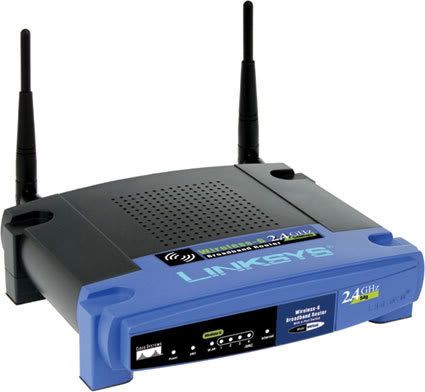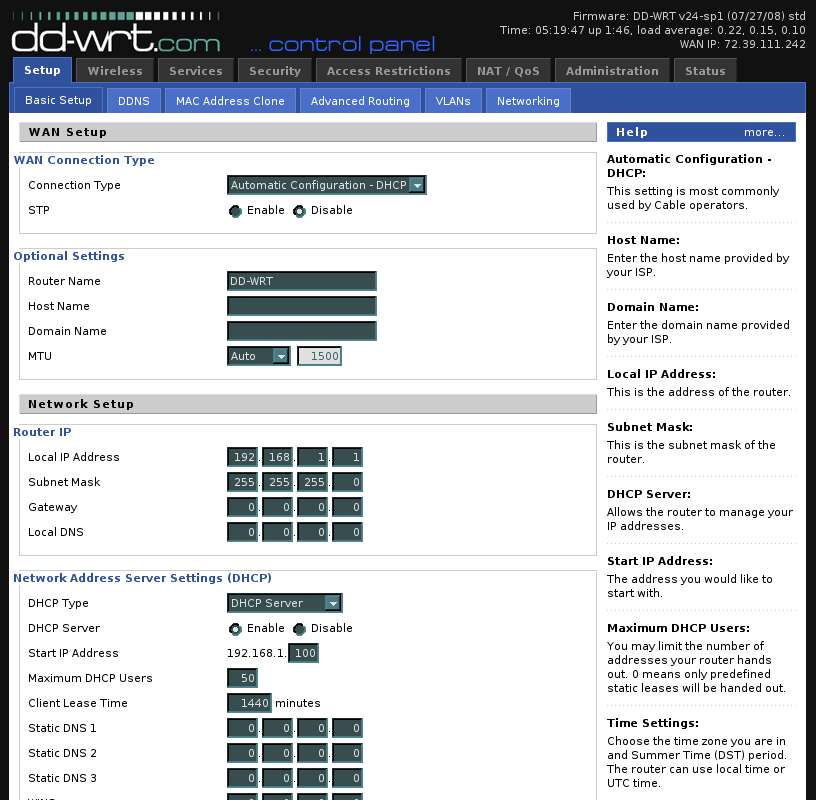For the last while my old D-Link 524 has been getting touchy; the connection for a while would periodically drop for a second, and the DNS resolution was for whatever reason lagging. So opting for a replacement, what better, I thought, than NewEgg.com's 21x Customer Choice Award winner, the Linksys WRT54GL.

The killer functionality of the WRT54GL is that it runs off of Linux firmware, so there are plenty of available options for upgraded firmware. It's not the only router that has this ability, but it's certainly the most popular.
So this week I've focused on DD-WRT wireless router firmware.

There are several different versions of the firmware to fit better depending on your hardware capacity and personal requirements. Each has different features, with the 8MB mega version containing everything. I set up the standard firmware, which don't let it fool you, has what I believe the technical term is "crapload" of features.
It supports, among plenty of other things, cron jobs, overclocking, SSH, real-time statistics and bandwidth monitoring, all in 14 different languages. I'd go through more of what's available, but there's plenty in there that I honestly have no idea what it's for.
If I may take you briefly into the past, in my blog post, Enemies of Information, I can be quoted as saying with regard to port 445, "merely passing your connection through a router at default settings will likely do the trick on its own." While I had forgotten to try this with the WRT54GL's default firmware, DD-WRT passes with flying colours.
There's no way for me to properly review the true value of DD-WRT because its capabilities reach far beyond my own needs, and thusly is likely more than enough for the typical user.
For those who need a guide to updating their firmware, Lifehacker has done it excellently. Now if you don't mind, I've got a lot of needless tinkering to do.

The killer functionality of the WRT54GL is that it runs off of Linux firmware, so there are plenty of available options for upgraded firmware. It's not the only router that has this ability, but it's certainly the most popular.
So this week I've focused on DD-WRT wireless router firmware.

There are several different versions of the firmware to fit better depending on your hardware capacity and personal requirements. Each has different features, with the 8MB mega version containing everything. I set up the standard firmware, which don't let it fool you, has what I believe the technical term is "crapload" of features.
It supports, among plenty of other things, cron jobs, overclocking, SSH, real-time statistics and bandwidth monitoring, all in 14 different languages. I'd go through more of what's available, but there's plenty in there that I honestly have no idea what it's for.
If I may take you briefly into the past, in my blog post, Enemies of Information, I can be quoted as saying with regard to port 445, "merely passing your connection through a router at default settings will likely do the trick on its own." While I had forgotten to try this with the WRT54GL's default firmware, DD-WRT passes with flying colours.
There's no way for me to properly review the true value of DD-WRT because its capabilities reach far beyond my own needs, and thusly is likely more than enough for the typical user.
For those who need a guide to updating their firmware, Lifehacker has done it excellently. Now if you don't mind, I've got a lot of needless tinkering to do.
Recently Spotted:
*crickets*

The number one function for a NAT router ought to be as a firewall. As such, you're still using it for more than simply connecting wirelessly, even at factory defaults.
Is there any negative to overclocking stuff, like it will burn out much faster? Or why doesn't everyone overclock everything to maximize performance for the lowest cost.
And Raven, you see the problem there is that you updated with the Linksys firmware
Here is the equivalent Lifehacker article for Tomato.
♥ Tomato's bandwidth usage logging.
Bonus: blocking school night furries